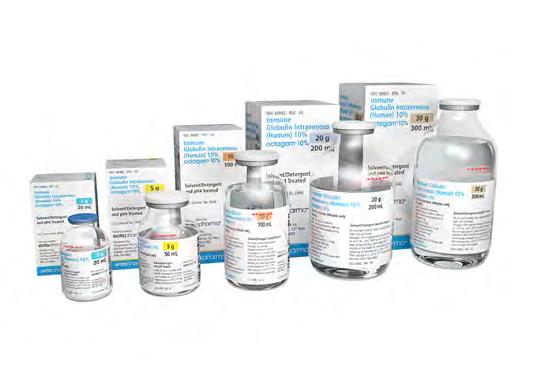Trial of Intravenous Immunoglobulin in Dermatomyositis
Aggarwal R,
Charles-Schoeman C, Schessl J, et al. NEJM. 2022;
submitted for publication.
REPRINT
Introduction:
• Glucocorticoids have been used as first-line therapy for adults with dermatomyositis (DM) followed by immunosuppressants. Intravenous immunoglobulin (IVIg) has been used second- or third-line, usually in combination with immunosuppressive drugs
• Progress in DERMatomyositis (ProDERM) is the first prospective, double-blind, randomized, placebo-controlled, multicenter, phase 3 trial to evaluate the long-term efficacy, tolerability, and safety of IVIg therapy with octagam 10% in a large multinational population of adults with DM
Methods:
• ProDERM enrolled 95 adult patients with active DM from 36 sites in 10 countries (17 sites in the US), including patients who were receiving standard immunosuppression (corticosteroids and/or immunosuppressants) or who previously failed or were intolerant to standard immunosuppression
• Patients were randomized to 2.0 g/kg octagam 10% (n=47) or placebo (n=48), administered every 4 weeks for 16 weeks. All patients treated with placebo and those without deterioration on octagam 10% could continue to the open-label extension phase, receiving 2.0 g/kg octagam 10% every 4 weeks for another 24 weeks



PRIMARY ENDPOINT:
Proportion of patients responding to treatment at Week 16, defined as improvement of ≥20 points on the total improvement score (TIS). TIS is based on 6 core set measures:
1. Physician global disease activity
2. Manual muscle testing
3. Muscle enzymes
Indications and Usage
4. Patient global disease activity
5. Health Assessment Questionnaire
6. Extramuscular disease activity
SECONDARY ENDPOINTS:
• Moderate or major TIS improvement
• TIS responders at 40 weeks
• Mean TIS from Week 4 to 40
• Cutaneous Dermatomyositis Disease Area and Severity Index (CDASI)
• Safety and tolerability
Octagam 10% is an immune globulin intravenous (human) liquid preparation indicated for the treatment of dermatomyositis (DM) in adults. Octagam 10% is also indicated for the treatment of chronic immune thrombocytopenic purpura (ITP) to rapidly raise platelet counts to control or prevent bleeding in adults.
WARNING: THROMBOSIS, RENAL DYSFUNCTION, and ACUTE RENAL FAILURE
Please see accompanying Full Prescribing Information for additional important information. Thrombosis may occur with immune globulin intravenous (IGIV) products, including Octagam 10%. Risk factors may include: advanced age, prolonged immobilization, hypercoagulable conditions, history of venous or arterial thrombosis, use of estrogens, indwelling vascular catheters, hyperviscosity, and cardiovascular risk factors. Thrombosis may occur in the absence of known risk factors.
Renal dysfunction, acute renal failure, osmotic nephropathy, and death may occur with the administration of Immune Globulin Intravenous (Human) (IGIV) products in predisposed patients. Renal dysfunction and acute renal failure occur more commonly in patients receiving IGIV products containing sucrose. Octagam 10% does not contain sucrose. For patients at risk of thrombosis, renal dysfunction or renal failure, administer Octagam 10% at the minimum dose and infusion rate practicable. Ensure adequate hydration in patients before administration. Monitor for signs and symptoms of thrombosis and assess blood viscosity in patients at risk for hyperviscosity.
Please see accompanying full Prescribing Information.
Octagam 10% Achieved Significant Improvement in TIS and Disease Severity in Adults With DM
PRIMARY ENDPOINT SIGNIFICANTLY MORE Patients Treated With Octagam 10%
ACHIEVED a TIS Response* at Week 16 vs Placebo
* Improvement of ≥20 points on TIS (based on 6 core set measures).
=percent change n=number of responders N=total number of patients
SECONDARY ENDPOINT 68% of Patients Treated With Octagam 10% Had an Increase in TIS of ≥40 points (MODERATE IMPROVEMENT) and 32% Had an Increase of ≥60 points (MAJOR IMPROVEMENT)
• In the placebo group, 23% of patients had moderate improvement and 8% had major improvement
to TIS Response
Shorter With
10% vs Placebo
Important Safety Information
Octagam 10% is contraindicated in patients who have a history of severe systemic hypersensitivity reactions, such as anaphylaxis, to human immunoglobulin. Octagam 10% contains trace amounts of IgA (average 106 μg/mL in a 10% solution). It is contraindicated in IgA-deficient patients with antibodies against IgA and history of hypersensitivity. Aseptic Meningitis Syndrome may occur in patients receiving Octagam 10%, especially with high doses or rapid infusion. The most common drug-related adverse reactions reported in >5% of the subjects during a clinical trial were headache, fever, nausea, vomiting, increased blood pressure, chills, musculoskeletal pain, increased heart rate, dyspnea, and infusions site reactions. Please see accompanying full Prescribing Information.
Significant Improvements Seen at Week 16 With Octagam 10% Were Maintained at 40 Weeks
SECONDARY ENDPOINT At Week 16, Mean TIS With Octagam 10% Was MORE THAN DOUBLE That of Placebo—and Was Maintained at 40 Weeks
TIS From Week 4 to 40
TIS rapidly improved in the placebo arm after patients were switched to octagam 10% at week 16.
SECONDARY ENDPOINT Efficacy With Octagam 10% Was MAINTAINED After 40 weeks in 71% of TIS responders
• After switch from placebo to octagam 10%, a similar TIS response was achieved (70%)
SECONDARY ENDPOINT Octagam 10% DECREASED CDASI Score at Week 16—and Continued Through 40 Weeks†
• Octagam 10% achieved a mean decrease of 9.4 points vs 1.2 points with placebo
Treatment With Octagam 10% Was Generally Well Tolerated
• 62 of 95 patients (65.3%) experienced 282 treatment-emergent adverse events
• Most common related adverse events were headache, pyrexia, and nausea
• Majority of adverse events were only mild in intensity
†Mean total activity score: erythema, scale, and erosion/ulceration. A 4- to 5-point decrease is considered clinical improvement.
Important Safety Information
Hemolysis that is either intravascular or due to enhanced red blood cell sequestration can develop subsequent to Octagam 10% treatments. Risk factors for hemolysis include high doses and non-O-blood group. Closely monitor patients for hemolysis and hemolytic anemia.
Please see accompanying full Prescribing Information.

